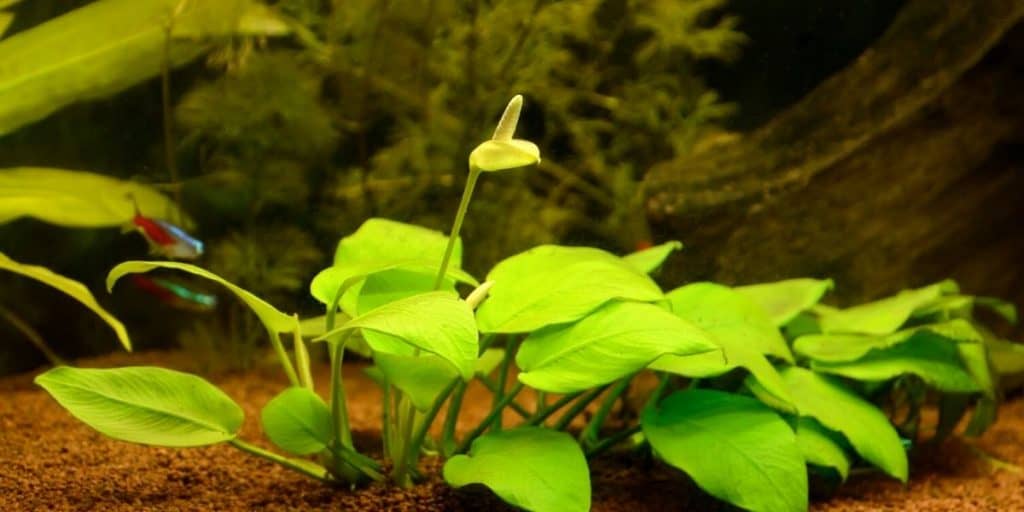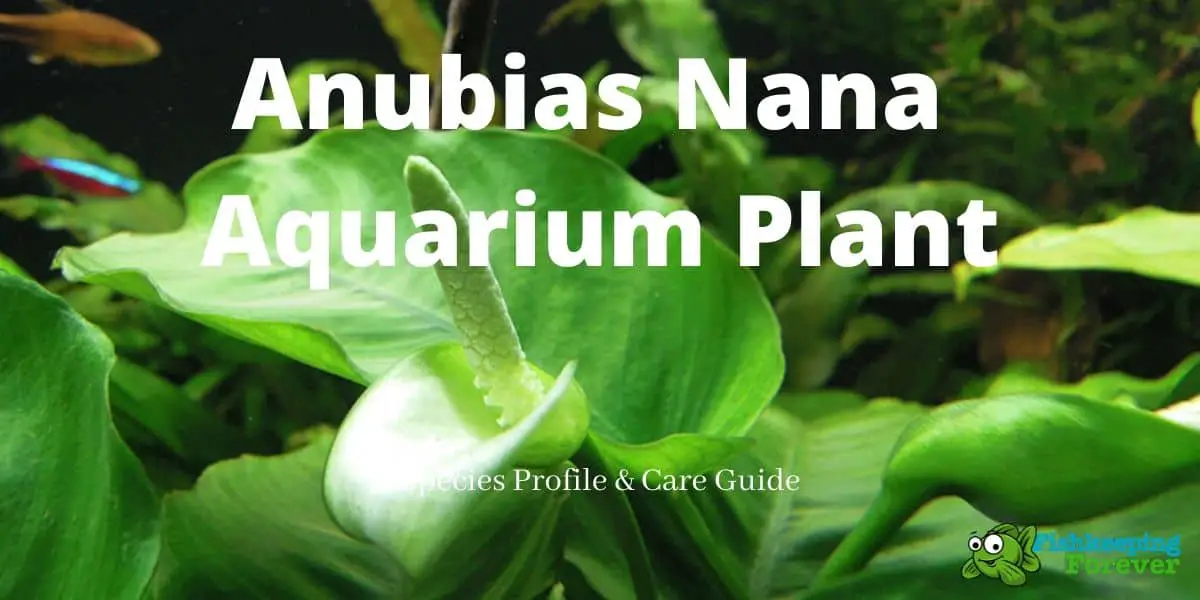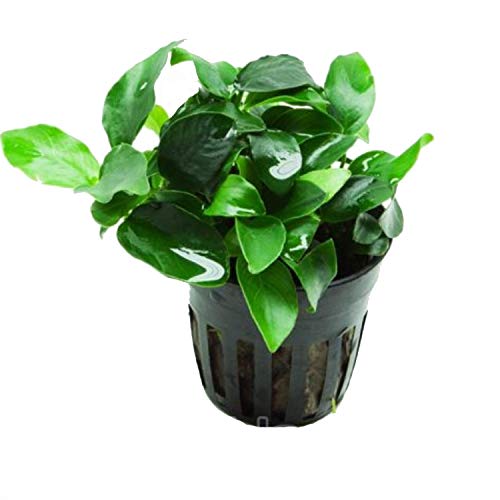If you are a freshwater aquarium enthusiast and looking to add some authentic greenery to a tank brimming with African freshwater species like tetras, cichlids, and distichodus, Anubias Nana is a low maintenance West African plant that can thrive in your aquarium. It is almost impossible to get the care, maintenance, and propagation of this small aquatic plant wrong as we explain below.
Novices can confidently get this broad-leaved flowering plant underway quickly and it will provide good cover and interest for your fish. Better still it is not especially appetizing to most fish meaning it should be a long-lasting addition to your tank.
Read on for our comprehensive guide to the Dwarf Anubias.
Table of Contents
Species Profile
The ‘Nana’ variant of Anubis Barteri is a freshwater aquatic plant that is native to West Africa. The Dwarf Anubias is a species of the Anubias genus. These flowering plants are semi-aquatic and characterized by their thick and broad leaves.
It is specifically found in and around forest rivers, streams marshes and ponds of Victoria, Cameroon, where it grows either fully or semi immersed. It is used to growing with minimal light, under the cover of a dense tree canopy, in murky water, or attached to rotting wood.
Names that Anubias Nana is known by
The Dwarf Anubias is from the Araceae family of monocotyledonous plants, with the Anubias genus within this grouping. The Nana species is a variety of Anubias Barteri first described in the 19th century by Heinrich Wilhelm Scot. It is this variety that is cultivated in volume for the aquarium trade.
The following names refer to Anubias Nana and its variants, some of which are quite rare:
- Nana
- Nana Gold
- Anubias nana petite
- Anubias barteri var. nana ‘petite’
- Anubias barteri var. ‘nana gold’
- Anubias Nana Golden
- Anubias Nana “Thick Leaf”
- Anubias ‘Golden Nana’
- Anubias Nana Snow White
- Anubias Snow White.
- Anubias nana ‘Bonsai’
Apart from its stature, the Dwarf Anubias is extremely similar to other Anubias plants with the characteristic heart-shaped waxy leaves that give it the nickname “the plastic plant that grows”! Other similar species include:
- Anubias barteri var. Angustifolia
- Anubias barteri var. glabra
- Anubias barteri var. glabra
These all come from the West African countries of Nigeria, Cameroon, and the island of Bioko (Equatorial Guinea).
Anubias Nana description
One of the most striking features of this plant is it’s thick leathery and almost plastic leaves which are broad with dark green veins. Leaves are petiolate with a pointed tip. White and Golden leaved varieties retain their coloring throughout their life cycle.
These compact broad leaves are on short stems and form a rosette arrangement in low clumps of ovoid glossy foliage. Anubias Nana has trailing roots that will take hold of driftwood or other objects in your tank. The Dwarf Nana can also bloom, producing a ‘calla lily-like’ flower that can last several weeks.
Size and shape
The lush thick leaves of the Nana plant grow to a length of 3 inches (7.5 cm) which form the majority of the height of this plant as it is short-stalked.
Its dark green clumps typically reach no more than 4.5 inches (11.5 cm), making it the shortest of the Anubias species. If it flowers it usually produces a solitary hard-wearing bloom on a long stalk.
Growth of the Anubias Nana
This is a slow-growing hardy plant that requires relatively little input. It will grow just as well either semi or fully emersed, making it a great pick for ponds and aquariums. Its leaves are very long-lasting and can be retained for years at a time. The plant spreads with a gradual creeping growth pattern and usually produces one new leaf per month.
The Dwarf Anubias grows from a key structure called the rhizome which stores the nutrients on which the plants rely. Roots grow downwards from the rhizome and the stems and thick leaves grow up and out from it. The rhizome should be preserved as even if the leaves are damaged or lost they will gradually grow again.
Caring for your Nana plant
Anubias Nana has a great reputation as a straightforward, easy to care aquatic plant that will last a long time in your tank. It is a great plant to learn the basics of aquascaping with, as there is very little you or your fish can do to kill it! It absorbs nutrients slowly and does well on a range of substrates and surfaces without any extras. Keeping your tank clean with weekly water changes should keep this plant.
Optimum Water Chemistry
Dwarf Anubias will tolerate a range of freshwater conditions meaning that it can be used to complement aquariums for a wide range of fish species. Softer mildly acidic water conditions are preferable and the Nana should thrive irrespective of water hardness.
- The ideal pH for the Nana lies between 6 and 7.
- Suitable water hardness for Anubias Nana: 2-16 dGH.
- The salinity of up to 1.005 means that this plant can even survive in a brackish tank.

Optimum Temperature of the Dwarf Anubias
Given its tropical natural habitat, it is understandable that the Nana will need warmer water temperatures. Cold water will stunt the growth of this plant and therefore should be kept between 22 and 28 degrees Celsius (72 to 82 degrees Fahrenheit).
Lighting can be kept low for this plant, or adjusted according to the needs of other plant species in your tank. Excessive lighting can precipitate the growth of algae on the plant which stains the leaves of the Nana.
Supplemental nutrition and CO2 are non-essential for Anubias Nana and can also cause algal growth. Any algal growth can be reduced by adding complementary plants that will absorb excess nitrogen.
The best substrate for the Anubias Nana
Anubias Nana will need to be planted as it is a root-feeding plant that stores up a reservoir of nutrients in its rhizome. You have a variety of substrate options to work with:
- Sand
- Gravel
- Porous rock
- Volcanic rock
- Soil granules
When planting, it is vital that the rhizome of the Nana is not buried as it will rot and kill the plant. The long roots can also be wrapped about driftwood, rocks, or other objects. If you are keeping your aquarium dim, dark-colored substrates are preferable.
Read our guide all about aquarium plant substrate here.
Aquascaping with the Dwarf Anubias
The hardiness of the Nana makes it a great choice for a tropical freshwater tank and it’s distinctive texture and appearance lend it to a variety of aquascaping projects. If you want to create an authentic African biotope, this will be a go-to pick. It works well as a foreground to mid-ground plant displayed against contrasting tones.
Complementary plants like Java Fern will keep your fish entertained. Keeping this plant in shaded areas helps to prevent algal growth. This makes it work well in a tank with floating aquatic plants like duckweed, Amazon Frogbit, or Water Lettuce, which also mop up any excess nitrogen. Weigh it down amongst stones or tie it with string to driftwood and the roots will do the rest.
When you first plant an emersed Dwarf Anubias underwater, you may experience leaf loss. This is simply due to the plant transitioning and the lost foliage will recover. Keep your Nanas in shape by trimming dead leaves and picking off any daughter plants that appear at the rhizome.
Propagating your Anubias Nana
The Nana is usually propagated from the rhizome at the base of the plant. Clean cut pieces of the rhizome will each give rise to a new plant. The rhizome can also be notched to produce a new stem and leaf that can be removed to form a new plant. Above water, the Dwarf Anubias will grow faster and can bloom and be pollinated to produce seeds.
F.A.Q – Anubias
Q. Is the Dwarf Anubias safe for fish?
A. Yes! This plant is non-toxic and tends not to be nibbled by most fish species. This makes the Nana a long-lived plant in most tanks.
Q. Why has my Nana got yellowing leaves?
A. It can be disheartening to see such an easy to maintain plant go yellow, but patience is advised. If you have recently planted the Dwarf Anubias, it is likely that you have buried the rhizome and it is starting to rot. Also,a plant that was growing out of the water before being submerged is likely to ‘melting’ and will eventually grow new hardier leaves underwater.
Q. How do I get Black Beard algae spots off my Anubias Nana?
A. Algae can be a hassle with this plant and black spots do look unsightly. Your options for remedying this include getting algae-eating fish on the job, cleaning leaves with peroxide, or adding carbon dioxide to the water.
Conclusion: Dwarf Anubias
The Dwarf Anubias is a great fish-friendly plant for adding a touch of the exotic to any tank. As it can be easily established, grown, and propagated a few plants are enough to drive a range of aquascaping projects which even a novice can complete with confidence!
You can buy it on Amazon

I have been working in the tropical fish industry for over 30 years now and I’m still learning. Everyday is a school day in this hobby. In my spare time I play golf very badly!









